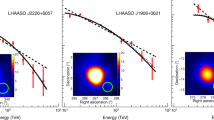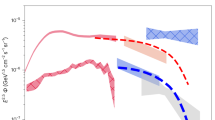Abstract
High-energy cosmic-ray electrons and positrons (CREs), which lose energy quickly during their propagation, provide a probe of Galactic high-energy processes1,2,3,4,5,6,7 and may enable the observation of phenomena such as dark-matter particle annihilation or decay8,9,10. The CRE spectrum has been measured directly up to approximately 2 teraelectronvolts in previous balloon- or space-borne experiments11,12,13,14,15,16, and indirectly up to approximately 5 teraelectronvolts using ground-based Cherenkov γ-ray telescope arrays17,18. Evidence for a spectral break in the teraelectronvolt energy range has been provided by indirect measurements17,18, although the results were qualified by sizeable systematic uncertainties. Here we report a direct measurement of CREs in the energy range 25 gigaelectronvolts to 4.6 teraelectronvolts by the Dark Matter Particle Explorer (DAMPE)19 with unprecedentedly high energy resolution and low background. The largest part of the spectrum can be well fitted by a ‘smoothly broken power-law’ model rather than a single power-law model. The direct detection of a spectral break at about 0.9 teraelectronvolts confirms the evidence found by previous indirect measurements17,18, clarifies the behaviour of the CRE spectrum at energies above 1 teraelectronvolt and sheds light on the physical origin of the sub-teraelectronvolt CREs.
This is a preview of subscription content, access via your institution
Access options
Access Nature and 54 other Nature Portfolio journals
Get Nature+, our best-value online-access subscription
$29.99 / 30 days
cancel any time
Subscribe to this journal
Receive 51 print issues and online access
$199.00 per year
only $3.90 per issue
Buy this article
- Purchase on Springer Link
- Instant access to full article PDF
Prices may be subject to local taxes which are calculated during checkout


Similar content being viewed by others
References
Meyer, P. Cosmic rays in the Galaxy. Annu. Rev. Astron. Astrophys. 7, 1–38 (1969)
Strong, A. W., Moskalenko, I. V. & Ptuskin, V. S. Cosmic-ray propagation and interactions in the Galaxy. Annu. Rev. Nucl. Part. Sci. 57, 285–327 (2007)
Fan, Y. Z., Zhang, B. & Chang, J. Electron/positron excesses in the cosmic ray spectrum and possible interpretations. Int. J. Mod. Phys. D 19, 2011–2058 (2010)
Shen, C. S. Pulsars and very high-energy cosmic-ray electrons. Astrophys. J. 162, L181–L186 (1970)
Aharonian, F. A., Atoyan, A. M. & Voelk, H. J. High energy electrons and positrons in cosmic rays as an indicator of the existence of a nearby cosmic tevatron. Astron. Astrophys. 294, L41–L44 (1995)
Moskalenko, I. V. & Strong, A. W. Production and propagation of cosmic-ray positrons and electrons. Astrophys. J. 493, 694–707 (1998)
Kobayashi, T., Komori, Y., Yoshida, K. & Nishimura, J. The most likely sources of high-energy cosmic-ray electrons in supernova remnants. Astrophys. J. 601, 340–351 (2004)
Turner, M. & Wilczek, F. Positron line radiation as a signature of particle dark matter in the halo. Phys. Rev. D 42, 1001–1007 (1990)
Bertone, G., Hooper, D. & Silk, J. Particle dark matter: evidence, candidates and constraints. Phys. Rep. 405, 279–390 (2005)
Feng, J. L. Dark matter candidates from particle physics and methods of detection. Annu. Rev. Astron. Astrophys. 48, 495–545 (2010)
Nishimura, J. et al. Emulsion chamber observations of primary cosmic-ray electrons in the energy range 30–1000 GeV. Astrophys. J. 238, 394–409 (1980)
Chang, J. et al. (The ATIC Collaboration) An excess of cosmic ray electrons at energies of 300–800 GeV. Nature 456, 362–365 (2008)
Abdo, A. A. et al. (The Fermi-LAT Collaboration) Measurement of the cosmic ray e++ e− spectrum from 20 GeV to 1 TeV with the Fermi Large Area Telescope. Phys. Rev. Lett. 102, 181101 (2009)
Aguilar, M. et al. (The AMS-02 Collaboration) Precision measurement of the (e++ e−) flux in primary cosmic rays from 0.5 GeV to 1 TeV with the Alpha Magnetic Spectrometer on the International Space Station. Phys. Rev. Lett. 113, 221102 (2014)
Adriani, O. et al. (The PAMELA collaboration) Cosmic-ray electron flux measured by the PAMELA experiment between 1 and 625 GeV. Phys. Rev. Lett. 106, 201101 (2011)
Abdollahi, S. et al. (The Fermi LAT Collaboration) Cosmic-ray electron+positron spectrum from 7 GeV to 2 TeV with the Fermi Large Area Telescope. Phys. Rev. D 95, 082007 (2017)
Aharonian, F. et al. (The H.E.S.S. Collaboration) Energy spectrum of cosmic-ray electrons at TeV energies. Phys. Rev. Lett. 101, 261104 (2008)
Aharonian, F. et al. (The H.E.S.S. Collaboration) Probing the ATIC peak in the cosmic-ray electron spectrum with H.E.S.S. Astron. Astrophys. 508, 561–564 (2009)
Chang, J. et al. (The DAMPE collaboration) The Dark Matter Particle Explorer mission. Astropart. Phys. 95, 6–24 (2017)
Zhang, Z. Y. et al. Design of a high dynamic range photomultiplier base board for the BGO ECAL of DAMPE. Nucl. Instrum. Methods A 780, 21–26 (2015)
Yue, C. et al. A parameterized energy correction method for electromagnetic showers in BGO-ECAL of DAMPE. Nucl. Instrum. Methods A 856, 11–16 (2017)
Zhang, Z. Y. et al. The calibration and electron energy reconstruction of the BGO ECAL of the DAMPE detector. Nucl. Instrum. Methods A 836, 98–104 (2016)
Chang, J. et al. (The ATIC Collaboration) Resolving electrons from protons in ATIC. Adv. Space Res. 42, 431–436 (2008)
Accardo, L. et al. (The AMS collaboration) High statistics measurement of the positron fraction in primary cosmic rays of 0.5–500 GeV with the Alpha Magnetic Spectrometer on the International Space Station. Phys. Rev. Lett. 113, 121101 (2014)
Hooper, D., Cholis, I., Linden, T. & Fang, K. HAWC observations strongly favor pulsar interpretations of the cosmic-ray positron excess. Phys. Rev. D 96, 103013 (2017)
Blasi, P. Origin of the positron excess in cosmic rays. Phys. Rev. Lett. 103, 051104 (2009)
Hooper, D., Blasi, P. & Serpico, P. D. Pulsars as the sources of high energy cosmic ray positrons. J. Cosmol. Astropart. Phys. 0901, 025 (2009)
Abdollahi, S. et al. (The Fermi-LAT Collaboration) Search for cosmic-ray electron and positron anisotropies with seven years of Fermi Large Area Telescope data. Phys. Rev. Lett. 118, 091103 (2017)
Bergström, L., Edsjö, J. & Zaharijas, G. Dark matter interpretation of recent electron and positron data. Phys. Rev. Lett. 103, 031103 (2009)
Adriani, O. et al. (The PAMELA Collaboration) An anomalous positron abundance in cosmic rays with energies 1.5–100 GeV. Nature 458, 607–609 (2009)
Chang, J . et al. On the detection and identification of cosmic gamma-rays in a cosmic ray detector. In Proceedings of the 26th International Cosmic Ray Conference (Salt Lake City) (eds Kieda, D . Salamon, M . & Dingus, B. ) Vol. 5, 37 (1999); https://galprop.stanford.edu/elibrary/icrc/1999/proceedings/root/vol5/o4_1_10.pdf
Schmidt, W. K. H. et al. On the identification of high energy cosmic ray electrons in the advanced thin ionization calorimeter (ATIC). In Proceedings of the 26th International Cosmic Ray Conference (Salt Lake City) (eds Kieda, D. Salamon, M. & Dingus, B.) Vol. 5, 41 (1999); https://galprop.stanford.edu/elibrary/icrc/1999/proceedings/root/vol5/o4_1_11.pdf
Agostinelli, S. et al. Geant4—a simulation toolkit. Nucl. Instrum. Methods A 506, 250–303 (2003)
Wu, X . et al. The Silicon-Tungsten Tracker of the DAMPE Mission. Proc. Sci. (ICRC2015) 1192 (2015); https://pos.sissa.it/236/1192/
Jolliffe, I. T. Principal Component Analysis (Springer, 1986)
Roe, B. P. et al. Boosted decision trees as an alternative to artificial neural networks for particle identification. Nucl. Instrum. Methods A 543, 577–584 (2005)
Zang, J. J . et al. Measurement of absolute energy scale of ECAL of DAMPE with geomagnetic rigidity cutoff. Proc. Sci. (ICRC2017) 197 (2017); https://pos.sissa.it/301/197/pdf
Ackermann, M. et al. Detection of the characteristic pion-decay signature in supernova remnants. Science 339, 807–811 (2013)
Acknowledgements
The DAMPE mission is funded by the strategic priority science and technology projects in space science of the Chinese Academy of Sciences. In China the data analysis was supported in part by the National Key R&D Program of China (number 2016YFA0400200), the National Basic Research Program of China (number 2013CB837000), the National Natural Science Foundation of China (numbers 11525313, 11622327 and U1738206) and the 100 Talents Program of Chinese Academy of Sciences. In Europe the activities and the data analysis are supported by the Swiss National Science Foundation (SNSF), Switzerland; the National Institute for Nuclear Physics (INFN), Italy.
Author information
Authors and Affiliations
Consortia
Contributions
This work is the result of the contributions and efforts of all the participating institutes, under the leadership of Purple Mountain Observatory, the Chinese Academy of Sciences. All authors have reviewed, discussed, and commented on the present results and on the manuscript. In line with collaboration policy, the authors are listed alphabetically.
Ethics declarations
Competing interests
The author declare no competing financial interests.
Additional information
Reviewer Information Nature thanks D. Hooper and the other anonymous reviewer(s) for their contribution to the peer review of this work.
Publisher's note: Springer Nature remains neutral with regard to jurisdictional claims in published maps and institutional affiliations.
Extended data figures and tables
Extended Data Figure 1 Comparison of the flight data and the Monte Carlo simulations of the ζ distributions.
All events have deposited energies between 500 GeV and 1 TeV in the BGO calorimeter. The error bars (±1σ) represent statistical uncertainties. As for the Monte Carlo (MC) simulation data, the black, green and red histograms represent the electrons, the protons and their sum, respectively.
Extended Data Figure 2 Ratios of the ζ values calculated from the P- and N-side readout data.
The events have deposited energies between 500 GeV and 1 TeV in the BGO calorimeter. The error bars (±1σ) represent statistical uncertainties. The red line represents a Gaussian fit to the data points. The mean of the ratios is 1.015 ± 0.002 and σ is 0.110 ± 0.005.
Extended Data Figure 3 Ratios of the energies reconstructed with the P- and N-side readout data.
All events have deposited energies between 500 GeV and 1 TeV in the BGO calorimeter. The error bars (±1σ) represent statistical uncertainties. The red line represents a Gaussian fit to the data, with a mean of 1.005 ± 0.005 and a σ of 0.016 ± 0.001.
Extended Data Figure 4 Comparison of two spectral models for the DAMPE CRE spectrum.
The dashed and solid lines show the best-fitting results of the single power-law and smoothly broken power-law models, respectively.
PowerPoint slides
Rights and permissions
About this article
Cite this article
DAMPE Collaboration. Direct detection of a break in the teraelectronvolt cosmic-ray spectrum of electrons and positrons. Nature 552, 63–66 (2017). https://doi.org/10.1038/nature24475
Received:
Accepted:
Published:
Issue Date:
DOI: https://doi.org/10.1038/nature24475
This article is cited by
-
Design of a high-dynamic-range prototype readout system for VLAST calorimeter
Nuclear Science and Techniques (2023)
-
Advances in nuclear detection and readout techniques
Nuclear Science and Techniques (2023)
-
Gamma-ray haloes around pulsars as the key to understanding cosmic-ray transport in the Galaxy
Nature Astronomy (2022)
-
Design and evaluation of prototype readout electronics for nuclide detector in Very Large Area Space Telescope
Nuclear Science and Techniques (2022)
-
The origin of galactic cosmic rays
Reviews of Modern Plasma Physics (2022)
Comments
By submitting a comment you agree to abide by our Terms and Community Guidelines. If you find something abusive or that does not comply with our terms or guidelines please flag it as inappropriate.



